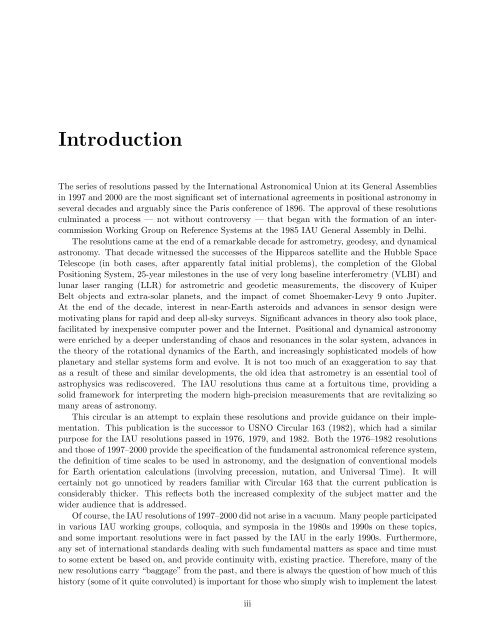USNO Circular 179 - U.S. Naval Observatory
USNO Circular 179 - U.S. Naval Observatory
USNO Circular 179 - U.S. Naval Observatory
Create successful ePaper yourself
Turn your PDF publications into a flip-book with our unique Google optimized e-Paper software.
Introduction<br />
The series of resolutions passed by the International Astronomical Union at its General Assemblies<br />
in 1997 and 2000 are the most significant set of international agreements in positional astronomy in<br />
several decades and arguably since the Paris conference of 1896. The approval of these resolutions<br />
culminated a process — not without controversy — that began with the formation of an intercommission<br />
Working Group on Reference Systems at the 1985 IAU General Assembly in Delhi.<br />
The resolutions came at the end of a remarkable decade for astrometry, geodesy, and dynamical<br />
astronomy. That decade witnessed the successes of the Hipparcos satellite and the Hubble Space<br />
Telescope (in both cases, after apparently fatal initial problems), the completion of the Global<br />
Positioning System, 25-year milestones in the use of very long baseline interferometry (VLBI) and<br />
lunar laser ranging (LLR) for astrometric and geodetic measurements, the discovery of Kuiper<br />
Belt objects and extra-solar planets, and the impact of comet Shoemaker-Levy 9 onto Jupiter.<br />
At the end of the decade, interest in near-Earth asteroids and advances in sensor design were<br />
motivating plans for rapid and deep all-sky surveys. Significant advances in theory also took place,<br />
facilitated by inexpensive computer power and the Internet. Positional and dynamical astronomy<br />
were enriched by a deeper understanding of chaos and resonances in the solar system, advances in<br />
the theory of the rotational dynamics of the Earth, and increasingly sophisticated models of how<br />
planetary and stellar systems form and evolve. It is not too much of an exaggeration to say that<br />
as a result of these and similar developments, the old idea that astrometry is an essential tool of<br />
astrophysics was rediscovered. The IAU resolutions thus came at a fortuitous time, providing a<br />
solid framework for interpreting the modern high-precision measurements that are revitalizing so<br />
many areas of astronomy.<br />
This circular is an attempt to explain these resolutions and provide guidance on their implementation.<br />
This publication is the successor to <strong>USNO</strong> <strong>Circular</strong> 163 (1982), which had a similar<br />
purpose for the IAU resolutions passed in 1976, 1979, and 1982. Both the 1976–1982 resolutions<br />
and those of 1997–2000 provide the specification of the fundamental astronomical reference system,<br />
the definition of time scales to be used in astronomy, and the designation of conventional models<br />
for Earth orientation calculations (involving precession, nutation, and Universal Time). It will<br />
certainly not go unnoticed by readers familiar with <strong>Circular</strong> 163 that the current publication is<br />
considerably thicker. This reflects both the increased complexity of the subject matter and the<br />
wider audience that is addressed.<br />
Of course, the IAU resolutions of 1997–2000 did not arise in a vacuum. Many people participated<br />
in various IAU working groups, colloquia, and symposia in the 1980s and 1990s on these topics,<br />
and some important resolutions were in fact passed by the IAU in the early 1990s. Furthermore,<br />
any set of international standards dealing with such fundamental matters as space and time must<br />
to some extent be based on, and provide continuity with, existing practice. Therefore, many of the<br />
new resolutions carry “baggage” from the past, and there is always the question of how much of this<br />
history (some of it quite convoluted) is important for those who simply wish to implement the latest<br />
iii


